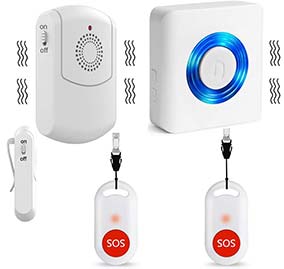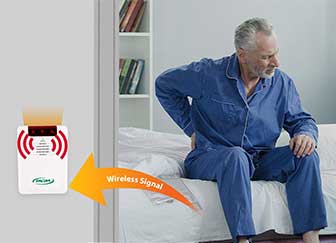As we age, it’s natural to prioritize safety, especially within the comforts of our own homes. For seniors, the risk of falls becomes a significant concern, as they can lead to serious injuries and a loss of independence.
However, with the advancements in technology, we now have an effective solution at our fingertips: the fall alert system.
Read ahead to understand the importance of fall alert systems and how they improve safety for seniors at home.
Understanding the Risks of Falls for Seniors
Before we explore the benefits of fall alert systems, it’s crucial to know the risks associated with falls for seniors.
Falls are a leading cause of injury and hospitalization among older adults. They can result in fractures, head injuries, and a decline in overall health. Moreover, the fear of falling can limit seniors’ mobility and hinder their ability to enjoy an independent lifestyle.
The Role of Fall Alert Systems
Fall alert systems are designed to detect and mitigate alert a caregiver or monitoring service that one has fallen or is in need of assistance. This adds a layer of security for seniors at home.
These systems vary in feature and function depending on their intended purpose. Common components can include motion sensors, wearable devices, and emergency alerts, which work together to minimize the risk of delayed response after a fall and slow treatment for an injury.
Key Features and Components of a Personal Medical Alert System
- Motion Sensors: Installed strategically throughout the home, motion sensors can detect movement patterns and identify potential hazards. They can send real-time alerts to caregivers or family members if an irregular movement or a fall is detected. Some models may even have two way communication channel open to be able to discuss potential safety concerns.
- Wearable Devices: Fall prevention systems often include wearable devices equipped with accelerometers and gyroscopes. These devices can detect sudden movements or changes in body position and trigger an alert to notify designated contacts.
- Emergency Alerts: In case of a fall, fall alert systems can automatically notify emergency services or family members, ensuring prompt assistance for the senior. Some systems even offer two-way communication features, allowing immediate interaction between the senior and the caregiver.
Benefits of Fall Alert Systems
A fall alert system can offer many benefits for seniors and their caregivers, such as:
- Early Detection: Fall alert systems can detect potential hazards before an accident occurs, allowing you to get help early.
- Timely Response: By providing instant alerts to caregivers or family members, fall prevention systems ensure a quick response to emergencies, reducing the time between a fall and receiving assistance. If one were to fall, help would be at the door in no time, reducing the risk of waiting on the floor in pain with no support coming.
- Peace of Mind: For seniors and their loved ones, fall alert systems offer peace of mind. Knowing that there is a way to request assistance can alleviate anxiety and allow seniors to maintain their independence.
- Improved Quality of Life: With enhanced safety, seniors can confidently move around their homes, engage in activities, and enjoy a higher quality of life without constant worry or fear of falling. A fall alert system can help seniors improve their physical and mental health by encouraging them to maintain a healthy lifestyle, preventing isolation and depression, and providing comfort and convenience.
What Happens When you Press The Button to Initiate an Alert?
When you press the call button at home, it initiates a series of actions to ensure that your request for assistance is attended to promptly. Here’s a typical process that takes place:
- Notification: The moment you press the call button, it sends a signal to a centralized monitoring station or a nurse’s station, indicating that you need assistance.
- Alerting the Staff: The signal triggers an alert on a computer or a pager carried by the monitoring service or healthcare professionals responsible for responding to safety calls. They receive immediate notification about the location and urgency of the call.
- Response Time: Once alerted, the monitoring service or healthcare professional will respond to your call as soon as possible. Response times may vary based on factors such as the workload of the staff and the urgency of the situation.
- Assistance and Evaluation: When your personal contacts arrive or emergency services are deployed to your room or location, they will inquire about your needs and provide the necessary assistance. They may help with tasks such as administering medication, providing pain relief, adjusting your position, or attending to any other immediate concerns such as a fall.
- Action: Your caregiver or the emergency team will make an observation of the situation and take action to either get you medical attention in a hospital or follow up with another health resource in a timely manner.
It’s important to note that response times can vary depending on the urgency and priority of other patient needs. In emergency situations or critical care settings, response times are typically expedited.
What Happens If I Accidentally Trigger a Fall Alert System?
A personal alert system can be automatically trigged by a fall (if the system has an automatic fall detection feature) or manually by pressing a button.
In periods of stress, you may accidentally press the button initiating a false alarm. The monitoring service or caregiver will check in with you to ensure everything is alright. Once they have determined there are no concerns, you can go about your daily tasks.
Choosing the Right Fall Prevention System
When selecting a fall prevention system, it’s essential to consider the specific needs and living environment of the senior. Factors such as ease of use, reliability, and customer support should be taken into account. It’s advisable to research and compare different systems to find the one that best fits the individual’s requirements.
If you are interested in installing a fall prevention system at home for yourself or a loved one, you should consider several factors before making a decision, such as:
- The needs and preferences of the senior: You should assess the level of mobility, cognition, and health of the senior and choose a system that suits their needs and preferences. For example, some seniors may prefer a wearable device that they can carry with them everywhere, while others may prefer a camera that does not require any interaction
- The features and functions of the system: You should compare the features and functions of different systems and select one that meets your expectations and budget. For example, some systems may have more advanced technology and capabilities than others but may also cost more or require more maintenance.
- The reliability and security of the system: You should ensure that the system is reliable and secure and that it protects the privacy and dignity of the senior. For example, some systems may have backup batteries or cellular connections in case of power outages or internet disruptions; some systems may have encryption or authentication mechanisms to prevent unauthorized access or data breaches.
Alternate Fall Response Equipment Options
There are different types of fall prevention options available, such as:
- Wearable devices: The traditional fall prevention systems are worn by the senior on their wrist, neck, or belt, such as pendants, bracelets, or watches. They can detect falls using sensors and send signals to a base station or a smartphone app. Some wearable devices also have GPS tracking, emergency buttons, voice communication, and health monitoring features.
- Floor mats: These are mats that can be placed on the floor near the bed, the bathroom, or other high-risk areas. Depending on their thickness, they may be used to blunt someone’s fall and potentially reduce injuries from a fall. They can sense when a senior steps on them or falls on them and trigger an alarm or a notification.
- Chair and Bed Alarms: These devices are often placed directly underneath the bottom of someone that is sitting on a chair. When an individual attempts to stand up, the alarm sirens a nearby caregiver to come and assist.
For the cognitively impaired, the use of this device may confuse if training is not provided consistently or one’s memory is affected.
Cameras: These are cameras that can be installed in strategic locations around the home, such as the living room, the kitchen, or the hallway. They can capture images or videos of seniors and use artificial intelligence to analyze their behavior and detect falls or other anomalies. Some cameras also have motion detection, night vision, face recognition, and two-way communication capabilities.
- Smart home systems: These are systems that can integrate various devices and sensors in the home, such as door locks, smoke detectors, thermostats, lights, and speakers. They can create a smart environment that adapts to the needs and preferences of seniors and provides safety and comfort. For example, they can automatically turn on the lights when a senior gets up at night, lock the doors when they leave the house, or play soothing music when they are stressed.
Why Are Falls Dangerous?
Falls are one of the leading causes of injury and death among older adults. According to the Centers for Disease Control and Prevention (CDC), one in four Americans aged 65 and older falls each year, and more than 36,000 die from fall-related injuries. Falls can also result in fractures, head trauma, disability, loss of independence, and reduced quality of life.
Fortunately, there are ways to prevent falls and protect seniors from their devastating consequences. One of them is installing a fall prevention system at home. A fall prevention system is a device or a service that monitors the movements and activities of seniors and alerts caregivers or emergency responders in case of a fall or an abnormal situation.
Conclusion
The safety and well-being of seniors should always be a priority, particularly when it comes to preventing falls.
A fall prevention system is a valuable investment that can improve safety at home for seniors.
By choosing the right system for your situation, you can reduce the harm from falls and injuries, increase independence and confidence, enhance quality of life and well-being for yourself or your loved one.
Fall alerts systems offer a retirement solution to minimize risks, detect hazards, and ensure prompt assistance in case of emergencies.
By embracing this technology, we can empower seniors to age in place confidently, maintaining their independence and enjoying a safer and more fulfilling lifestyle.
Invest in a fall prevention system today and provide your loved ones with the protection they deserve.


